 Here's a cool little illusion, borrowed from John Sadowski, of some deer on Miyajima Island during our 2002 trip to Japan. I couldn't make it fit in the blog, so click this link to see it in action. Before you click, here are the directions: first, keep your mouse cursor off the image. Try hovering over it once or twice and notice that if you hover, the picture turns to black and white. Keeping the cursor off of the image, stare at the black dot in the center for 30 seconds, without moving your head or eyes. While continuing to stare at the dot, move the mouse back over the image -- voila, you should be able to see color! The color will remain as long as you don't move your eyes.
Here's a cool little illusion, borrowed from John Sadowski, of some deer on Miyajima Island during our 2002 trip to Japan. I couldn't make it fit in the blog, so click this link to see it in action. Before you click, here are the directions: first, keep your mouse cursor off the image. Try hovering over it once or twice and notice that if you hover, the picture turns to black and white. Keeping the cursor off of the image, stare at the black dot in the center for 30 seconds, without moving your head or eyes. While continuing to stare at the dot, move the mouse back over the image -- voila, you should be able to see color! The color will remain as long as you don't move your eyes.
Norm's musings
Saturday, October 27, 2007
Deer illusion
 Here's a cool little illusion, borrowed from John Sadowski, of some deer on Miyajima Island during our 2002 trip to Japan. I couldn't make it fit in the blog, so click this link to see it in action. Before you click, here are the directions: first, keep your mouse cursor off the image. Try hovering over it once or twice and notice that if you hover, the picture turns to black and white. Keeping the cursor off of the image, stare at the black dot in the center for 30 seconds, without moving your head or eyes. While continuing to stare at the dot, move the mouse back over the image -- voila, you should be able to see color! The color will remain as long as you don't move your eyes.
Here's a cool little illusion, borrowed from John Sadowski, of some deer on Miyajima Island during our 2002 trip to Japan. I couldn't make it fit in the blog, so click this link to see it in action. Before you click, here are the directions: first, keep your mouse cursor off the image. Try hovering over it once or twice and notice that if you hover, the picture turns to black and white. Keeping the cursor off of the image, stare at the black dot in the center for 30 seconds, without moving your head or eyes. While continuing to stare at the dot, move the mouse back over the image -- voila, you should be able to see color! The color will remain as long as you don't move your eyes.
Sunday, October 07, 2007
Best Papaya Seed Dressing Recipe
 Here's the recipe for the absolutely best papaya seed salad dressing, obtained from Ono Family Restaurant, a small restaurant in Kauai just before they changed ownership. For the best results, use only papaya seeds from a sweet fruit, and absolutely do not use normal white, brown, or red onions -- only a Maui onion will do, trust me on this!
Here's the recipe for the absolutely best papaya seed salad dressing, obtained from Ono Family Restaurant, a small restaurant in Kauai just before they changed ownership. For the best results, use only papaya seeds from a sweet fruit, and absolutely do not use normal white, brown, or red onions -- only a Maui onion will do, trust me on this!Papaya Seed Dressing
1 C sugar
1 t salt
1 t dry mustard (Coleman's)
1 small Maui onion, quartered to blend easier
1 T papaya seeds (seeds only, no fruit); can substitute poppy seeds if need be
1 C red wine vinegar
2-3 C vegetable oil
1 C pineapple juice
Blend in blender, makes approx. 4 C dressing. Serve over cold, fresh greens. Store leftover dressing in sealed container in fridge for up to 2 weeks.
Monday, July 10, 2006
Homemade curry
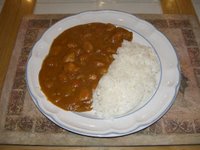 Mmmm, curry chicken. It's one of my favorite eats and Curry House has a pretty good rendition of the curry I had all around Tokyo when we visited in 2002; I especially like it with the red pickles (Fukujin Zuke). If you've never had Japanese curry, it's nothing at all like Indian or Thai curry which tend to be runny or coconut based, instead having a thick consistency that goes well with rice.
Mmmm, curry chicken. It's one of my favorite eats and Curry House has a pretty good rendition of the curry I had all around Tokyo when we visited in 2002; I especially like it with the red pickles (Fukujin Zuke). If you've never had Japanese curry, it's nothing at all like Indian or Thai curry which tend to be runny or coconut based, instead having a thick consistency that goes well with rice.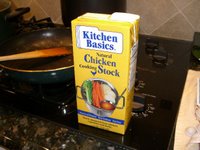 I've known for a while that the box curry (usually House brand, but others are good too) is not all that healthy, with palm oil being a predominant ingredient. Although palm oil turns out not to be nearly as bad as previously thought, I would prefer not to add too much saturated fat to my diet. Thus it was with great interest that I came upon a couple of homemade Japanese-style curry recipes on the 'net. With the help of Google and our friend Jane (who helped with some of the poor English translation), I was able to create a very tasty curry without all that sat fat. It basically involves creating the roux from S&B curry powder, flour, and oil (I use olive oil because it's supposed to be the healthiest). The recipe is available (poor English and all) here; in case the link is broken, the recipe is mostly duplicated at the end of this post. I use boxed chicken stock (from Trader Joe's) instead of boullion cubes, which has way too much sodium and MSG.
I've known for a while that the box curry (usually House brand, but others are good too) is not all that healthy, with palm oil being a predominant ingredient. Although palm oil turns out not to be nearly as bad as previously thought, I would prefer not to add too much saturated fat to my diet. Thus it was with great interest that I came upon a couple of homemade Japanese-style curry recipes on the 'net. With the help of Google and our friend Jane (who helped with some of the poor English translation), I was able to create a very tasty curry without all that sat fat. It basically involves creating the roux from S&B curry powder, flour, and oil (I use olive oil because it's supposed to be the healthiest). The recipe is available (poor English and all) here; in case the link is broken, the recipe is mostly duplicated at the end of this post. I use boxed chicken stock (from Trader Joe's) instead of boullion cubes, which has way too much sodium and MSG.Although there is a little bit more effort in creating the curry from scratch, the final product is very good, and rivals the stuff you'd get at Curry House or out of a box. Give it a try, you might be surprised!
Recipe (courtesy Mariko at jpn-miyabi.com. my comments in brackets):
Ingredients (serving for 4)
200g sliced pork loin, 1 teaspoon curry powder, 1+1/2 onion, 1 carrot,
1 laurel, 1 tbsp grated garlic, 10g grated ginger, 2 tbsp ketchup,
2 tbsp Worcester [sic] sauce, 1/2 tbsp sugar, 1/2 tbsp salt,
1 tbsp honey, 1 teaspoon instant coffee
3 cups rice (1cup = 180cc)
Preparing
1. Cut sliced pork into 2-3cm width and coat with curry powder [I use chicken, and don't bother to coat with powder, but do dust with baking soda which gets washed off to make the meat more tender].
2. Cut onion and carrot into bite-sized [pieces].
3. Heat vegetable oil on a pot, cook onion until became softly
and add honey.
4. Add soup, bring to boil up and turn down the heat .
Get rid of harshness.(A)
To add honey is familiar to well-cooked onion taste [i.e., honey adds to the traditional caramelized flavor].
How to cook curry roux
1. Heat vegetable oil in a frying pan, add flour slowly,
stir constantly until well blended.
2. Remove the pan from the heat and put it on a towel
to cool it down.
3. Add curry powder to the pan and mix well.(B)
4. Pour (A) in (B)slowly. (C)
5. Pour (C) into the pot, add garlic, laurel [bay leaf], ketchup,
Worcester sauce, sugar and salt.
6. Boil well for 30 minutes [I think simmer is what it meant].
7. Pour instant coffee [a teaspoon or so of instant powder].
Instant coffee makes more rich taste.
["Secret ingredients" which are supposedly added to curry, let me know if you try any (*):
- Consomme
- Ginger
- Chocolate
- Instant coffee
- Tomato ketchup
- Apple, mango, and other fruits
- Honey
- Mayonnaise
- Worcestershire sauce
- Soy sauce
- Milk
- Garlic
- Laurel leaf
- Yogurt
- Wine]
* of course, a number of these items are, in fact, in the recipe already
Saturday, April 08, 2006
Homeroasting, Pt. 2
If you're still reading, I assume you want to know more about roasting at home, and about improving the quality of your coffee. Let me address the latter topic first; IMHO the most important factors in good coffee in decreasing order of importance, are (1) water (2) grinder (3) beans (4) brewing method. You might be surprised to see beans so far down the list, but since coffee is mostly water, it's no surprise that water should be number one. Simply put, if the water tastes good plain, then it's probably good for coffee; I usually use bottled or RO (reverse osmosis) water. The grinder is a critical part of the equation, as the amount of flavor extraction depends on how fine the grind is (which is why most recommend avoiding a blade or "whirly blade" grinder which tend to heat and crush the beans, destroying flavor). I currently use a Solis Maestro, which is a great starter burr grinder, but would love to get a Rancilio Rocky one day. I usually grind to almost espresso fine grind, even for drip, because I find the extraction is better. Beans we'll get to in a moment. Brewing method is a matter of personal taste, but the method used should use water about 200 deg F (most brewers don't even come close); I use a Bunn B10-B pourover which is known to provide water at the optimal temp, but there are other options. Also, many people don't use enough grounds for their coffee; the SCAA recommends 2 tablespoons ground coffee per 6 oz. water for a single cup of coffee.
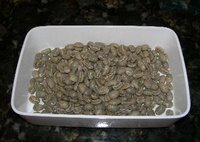 On to the actual roasting of beans. First, you need to find a supplier of green (unroasted) beans; sweetmarias is my provider of choice, but you may also be able to find a local roaster who is willing to sell you greens. The advantage of an online retailer is you will have access to many more varieties of beans. I like sweetmarias because they care about quality and will not sell old beans; they also offer some sampler packs so you can try a small amount of beans from a wide range of locales to see what you like best. To actually roast, you also need to invest in a roaster, from very cheap (certain -- but not all -- popcorn poppers, like the Westbend Poppery I/II, will do nicely as a starter roaster) to moderately priced (like the iRoast 2), to expensive (like the HotTop). If you are adventurous, you can also roast with a heat gun and dog bowl (!), a Stir Crazy popcorn popper bottom combined with a Turbo Oven top (aka the SC/TO beast), or even a large drum attached to a rotisserie fitted in a gas barbecue.
On to the actual roasting of beans. First, you need to find a supplier of green (unroasted) beans; sweetmarias is my provider of choice, but you may also be able to find a local roaster who is willing to sell you greens. The advantage of an online retailer is you will have access to many more varieties of beans. I like sweetmarias because they care about quality and will not sell old beans; they also offer some sampler packs so you can try a small amount of beans from a wide range of locales to see what you like best. To actually roast, you also need to invest in a roaster, from very cheap (certain -- but not all -- popcorn poppers, like the Westbend Poppery I/II, will do nicely as a starter roaster) to moderately priced (like the iRoast 2), to expensive (like the HotTop). If you are adventurous, you can also roast with a heat gun and dog bowl (!), a Stir Crazy popcorn popper bottom combined with a Turbo Oven top (aka the SC/TO beast), or even a large drum attached to a rotisserie fitted in a gas barbecue.
 I myself have a FreshRoast Plus, and a Poppery II I picked up off eBay for cheap as a backup roaster (again, note that you cannot use just any old popcorn popper; some designs can actually make the beans catch fire!). The Poppery is okay, but does not have the ability to catch the chaff so you have to make provision for that. The FR+ is a good starter roaster, using hot air to roast and a clever chaff collector on top to minimize the cleanup. I still roast in the garage because the smell of roasting beans, contrary to what one might think, is not all that pleasant (the roasted beans, on the other hand, smell great); this also gives me easy access to the wet/dry vac to clean up the chaff from the collector. The FR+ roasts fast, a batch of 70 grams (which is about enough for a pot) is done in about 6 minutes for a full city roast plus two minutes for cool-down, yielding about 54 grams of roasted coffee beans. Although I tend to roast a little dark (about full city on the roasting scale), you have total control over the degree of roast with the FR+ (and with most roasting methods). Since I drink about a mug per day, this is enough to last me three days, when I start the process over again.
I myself have a FreshRoast Plus, and a Poppery II I picked up off eBay for cheap as a backup roaster (again, note that you cannot use just any old popcorn popper; some designs can actually make the beans catch fire!). The Poppery is okay, but does not have the ability to catch the chaff so you have to make provision for that. The FR+ is a good starter roaster, using hot air to roast and a clever chaff collector on top to minimize the cleanup. I still roast in the garage because the smell of roasting beans, contrary to what one might think, is not all that pleasant (the roasted beans, on the other hand, smell great); this also gives me easy access to the wet/dry vac to clean up the chaff from the collector. The FR+ roasts fast, a batch of 70 grams (which is about enough for a pot) is done in about 6 minutes for a full city roast plus two minutes for cool-down, yielding about 54 grams of roasted coffee beans. Although I tend to roast a little dark (about full city on the roasting scale), you have total control over the degree of roast with the FR+ (and with most roasting methods). Since I drink about a mug per day, this is enough to last me three days, when I start the process over again.
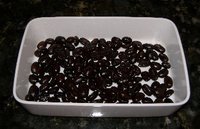 Finally, a note before I wrap up my treatment of homeroasting: there's no way I could do justice to the whole range of homeroasting methods and related matters in a single post or two. For the intrigued, I recommend the following websites:
Finally, a note before I wrap up my treatment of homeroasting: there's no way I could do justice to the whole range of homeroasting methods and related matters in a single post or two. For the intrigued, I recommend the following websites:
sweetmarias is where I started my HR journey and where I recommend you start too (the website layout is not the greatest, but the content and quality of beans, not to mention Tom's devotion to furthering the art of HR, is beyond compare).
ineedcoffee is small site that gives a nice overview of the homeroasting process, including tips on the easiest homeroaster, the Westbend Poppery I/II (I have one as a backup to my FreshRoast).
coffeegeek is a good all-around coffee aficionado site and a good source of reviews;
homeroaster.com is a generic homeroasting site, with lots of links. Includes ways to hack coffee equipment and a super cheap method (heatgun and dog bowl) that supposedly gives great control and results (though I've never tried it).
 On to the actual roasting of beans. First, you need to find a supplier of green (unroasted) beans; sweetmarias is my provider of choice, but you may also be able to find a local roaster who is willing to sell you greens. The advantage of an online retailer is you will have access to many more varieties of beans. I like sweetmarias because they care about quality and will not sell old beans; they also offer some sampler packs so you can try a small amount of beans from a wide range of locales to see what you like best. To actually roast, you also need to invest in a roaster, from very cheap (certain -- but not all -- popcorn poppers, like the Westbend Poppery I/II, will do nicely as a starter roaster) to moderately priced (like the iRoast 2), to expensive (like the HotTop). If you are adventurous, you can also roast with a heat gun and dog bowl (!), a Stir Crazy popcorn popper bottom combined with a Turbo Oven top (aka the SC/TO beast), or even a large drum attached to a rotisserie fitted in a gas barbecue.
On to the actual roasting of beans. First, you need to find a supplier of green (unroasted) beans; sweetmarias is my provider of choice, but you may also be able to find a local roaster who is willing to sell you greens. The advantage of an online retailer is you will have access to many more varieties of beans. I like sweetmarias because they care about quality and will not sell old beans; they also offer some sampler packs so you can try a small amount of beans from a wide range of locales to see what you like best. To actually roast, you also need to invest in a roaster, from very cheap (certain -- but not all -- popcorn poppers, like the Westbend Poppery I/II, will do nicely as a starter roaster) to moderately priced (like the iRoast 2), to expensive (like the HotTop). If you are adventurous, you can also roast with a heat gun and dog bowl (!), a Stir Crazy popcorn popper bottom combined with a Turbo Oven top (aka the SC/TO beast), or even a large drum attached to a rotisserie fitted in a gas barbecue. I myself have a FreshRoast Plus, and a Poppery II I picked up off eBay for cheap as a backup roaster (again, note that you cannot use just any old popcorn popper; some designs can actually make the beans catch fire!). The Poppery is okay, but does not have the ability to catch the chaff so you have to make provision for that. The FR+ is a good starter roaster, using hot air to roast and a clever chaff collector on top to minimize the cleanup. I still roast in the garage because the smell of roasting beans, contrary to what one might think, is not all that pleasant (the roasted beans, on the other hand, smell great); this also gives me easy access to the wet/dry vac to clean up the chaff from the collector. The FR+ roasts fast, a batch of 70 grams (which is about enough for a pot) is done in about 6 minutes for a full city roast plus two minutes for cool-down, yielding about 54 grams of roasted coffee beans. Although I tend to roast a little dark (about full city on the roasting scale), you have total control over the degree of roast with the FR+ (and with most roasting methods). Since I drink about a mug per day, this is enough to last me three days, when I start the process over again.
I myself have a FreshRoast Plus, and a Poppery II I picked up off eBay for cheap as a backup roaster (again, note that you cannot use just any old popcorn popper; some designs can actually make the beans catch fire!). The Poppery is okay, but does not have the ability to catch the chaff so you have to make provision for that. The FR+ is a good starter roaster, using hot air to roast and a clever chaff collector on top to minimize the cleanup. I still roast in the garage because the smell of roasting beans, contrary to what one might think, is not all that pleasant (the roasted beans, on the other hand, smell great); this also gives me easy access to the wet/dry vac to clean up the chaff from the collector. The FR+ roasts fast, a batch of 70 grams (which is about enough for a pot) is done in about 6 minutes for a full city roast plus two minutes for cool-down, yielding about 54 grams of roasted coffee beans. Although I tend to roast a little dark (about full city on the roasting scale), you have total control over the degree of roast with the FR+ (and with most roasting methods). Since I drink about a mug per day, this is enough to last me three days, when I start the process over again. Finally, a note before I wrap up my treatment of homeroasting: there's no way I could do justice to the whole range of homeroasting methods and related matters in a single post or two. For the intrigued, I recommend the following websites:
Finally, a note before I wrap up my treatment of homeroasting: there's no way I could do justice to the whole range of homeroasting methods and related matters in a single post or two. For the intrigued, I recommend the following websites:sweetmarias is where I started my HR journey and where I recommend you start too (the website layout is not the greatest, but the content and quality of beans, not to mention Tom's devotion to furthering the art of HR, is beyond compare).
ineedcoffee is small site that gives a nice overview of the homeroasting process, including tips on the easiest homeroaster, the Westbend Poppery I/II (I have one as a backup to my FreshRoast).
coffeegeek is a good all-around coffee aficionado site and a good source of reviews;
homeroaster.com is a generic homeroasting site, with lots of links. Includes ways to hack coffee equipment and a super cheap method (heatgun and dog bowl) that supposedly gives great control and results (though I've never tried it).
Sunday, March 26, 2006
Homeroasting, Pt. 1
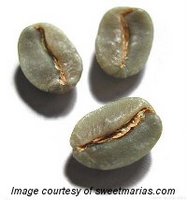 Before I get into the difference between a city and French roast, let me clear the air. I have nothing against Starbucks -- really I don't -- even though I usually refer to it as Charbucks. I'll even occasionally have a vente (or whatever fancy name they give it). But it irks me that people think you have to pay several bucks for a cup of quality coffee. I was never really that fond of SB, but after discovering homeroasting, I realized why, and what I had been missing.
Before I get into the difference between a city and French roast, let me clear the air. I have nothing against Starbucks -- really I don't -- even though I usually refer to it as Charbucks. I'll even occasionally have a vente (or whatever fancy name they give it). But it irks me that people think you have to pay several bucks for a cup of quality coffee. I was never really that fond of SB, but after discovering homeroasting, I realized why, and what I had been missing.Homeroasting is, simply put, roasting your own coffee from unroasted green beans. When I tell people about it, either I get back blank stares and the inevitable, "why?", or I pique their curiosity. Certainly, it's not for everyone. If you only drink your coffee with gobs of cream and sugar, you need read no further. Ditto if you only drink mocha caps with extra whipped cream. But if you enjoy a good cup of black coffee, with maybe a modicum of sugar, and don't mind a little bit of work, allow me to take you on a rewarding java journey. As an aside, once I got my my small group leader Dave homeroasting, despite previously being a big SB fan, he now agrees he would never go back again. In fact, his coworkers complain when he doesn't have homeroast available at work.
I've been roasting for several years now, and for those of you who know how frequently I fall into (and out of) hobbies, it is indeed a testament to the quality that I persist with homeroasting to this day. That's not to say that you can't make a decent cup of coffee without homeroasted beans -- you can, but it's a little harder. The problem with pre-roasted beans, even whole, is the taste begins to degrade in about a week or so, even in those fancy nitrogen-flushed canisters or bags, and even if you store in airtight jars or the freezer. And forget about pre-ground coffee. So unless you can buy fresh roasted coffee, get it home, and grind it within a week -- well, you get the idea. To put it more succinctly, here are some good reasons for homeroasting:
Homeroasted coffee is as fresh as you can get it; preroast coffee degrades quickly in quality Homeroasting allows you to experiment and have complete control over the roast levels; some beans do better darker, and some lighter You can try coffee from every corner of the world, for cheaper than preroasted You can store green (unroasted) beans for about a year without significant loss of flavor; try that with regular coffee You can expand your appreciation of coffee varietals greatly, kind of like wine appreciation And most importantly, homeroast tastes better than preroast
Some of the reasons you might not want to try homeroast: you'll need to obtain roasting equipment (though this can be quite cheap); you'll need to roast somewhere other than indoors (the smoke from roasting is, surprisingly, not that appealing); you'll end up spending more money buying new equipment in pursuit of a better cup of coffee; and you'll buy way more green beans than you need, just because you can :)
Favorite Japanese restaurants
 I enjoy Japanese cuisine, because it tends to be tasty and fairly healthy (tempura and sesame chicken excepted). I've noticed that a lot of Japanese restaurants in South OC, particularly popular ones, are run by Chinese or Koreans. Not that I have anything against them, and their food is often good, but somehow it just doesn't seem quite "right". That's why I'm always on the lookout for authentic Japanese restaurants, especially smaller mom-and-pop ones; besides noticing whether the restaurant is run by Japanese, I know I'm at the right place when the clientele is mostly Japanese. In Tustin, we like Honda Ya and Osaka Kappo. In Irvine, we often frequent Fukada.
I enjoy Japanese cuisine, because it tends to be tasty and fairly healthy (tempura and sesame chicken excepted). I've noticed that a lot of Japanese restaurants in South OC, particularly popular ones, are run by Chinese or Koreans. Not that I have anything against them, and their food is often good, but somehow it just doesn't seem quite "right". That's why I'm always on the lookout for authentic Japanese restaurants, especially smaller mom-and-pop ones; besides noticing whether the restaurant is run by Japanese, I know I'm at the right place when the clientele is mostly Japanese. In Tustin, we like Honda Ya and Osaka Kappo. In Irvine, we often frequent Fukada.Now if we could only get some good Hawaiian cuisine around here!
Subscribe to:
Posts (Atom)